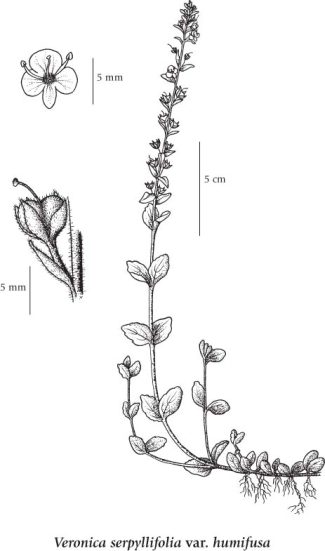Veronica serpyllifolia var. humifusa L. (Dicks.) Vahl
thyme-leaved speedwell
Plantaginaceae (Mare's-tail family)
(Previously in Scrophulariaceae)
Introduction to Vascular Plants
thyme-leaved speedwell
Plantaginaceae (Mare's-tail family)
(Previously in Scrophulariaceae)
Introduction to Vascular Plants
Map click to expand contents
Distribution of Veronica serpyllifolia var. humifusa
Click here to view the full interactive map and legend
Species Information click to expand contents
General:
Perennial herb from a creeping rhizome; stems ascending, 10-30 cm tall/long, often decumbent or creeping at the base and producing prostrate, nodally rooting branches, otherwise simple, finely and closely short-hairy, or smooth.
Leaves:
Opposite, often short-stalked below, unstalked above, elliptic to broadly egg-shaped, 1-2.5 cm long, obscurely blunt-toothed to entire, smooth or nearly so.
Flowers:
Inflorescence a terminal bracted raceme, at first compact then elongating and lax, of several to many (to 30) stalked flowers, the stalks finely short-hairy and often also glandular, shorter than the bracts, at least the upper bracts alternate, the lower gradually passing into leaves; corollas bright blue or pale blue to white with darker blue lines, saucer-shaped, 4-8 mm across, irregularly 4-lobed, the lobes much longer than the short tube, the upper lobe largest, the lowest lobe narrower than the others; calyces short-hairy or glandular-hairy, deeply 4-lobed, the lobes oblong to egg-shaped, 2-4 mm long, slightly unequal; styles short, 2-3.5 mm long; stamens 2, exserted, the filaments 1-4 mm long.
Fruits:
Capsules, 3-4 mm long, flattened, heart-shaped, wider than long, distinctly notched at the tip, thinly glandular-hairy; seeds numerous, about 0.7 mm long.
Notes:
Two varieties occur in BC
1. Axis of inflorescence and flower stalks minutely incurved-hairy, non-glandular; corollas to 5 mm wide; introduced in SW and E BC..................... var. serpyllifolia
1. Axis of inflorescence and flower stalks finely minute-hairy but also with spreading glandular hairs; corollas to 8 mm wide; native throughout BC..................... var. humifusa (Dickson) Vahl
Illustration click to expand contents

If more than one illustration is available for a species (e.g., separate illustrations were provided for two subspecies) then links to the separate images will be provided below. Note that individual subspecies or varietal illustrations are not always available.
Illustration Source: The Illustrated Flora of British Columbia
Ecology click to expand contents
Ecological Framework for Veronica serpyllifolia var. humifusa
The table below shows the species-specific information calculated from
original data (BEC database) provided by the BC Ministry of Forests and Range.
(Updated August, 2013)
The table below shows the species-specific information calculated from
original data (BEC database) provided by the BC Ministry of Forests and Range.
(Updated August, 2013)
| Site Information |
Value / Class |
||
|
Avg |
Min |
Max |
|
| Elevation
(metres) |
1800 | 1800 | 1800 |
| Slope
Gradient (%) |
|||
|
Aspect (degrees) |
0 | ||
| Soil
Moisture Regime (SMR) [0 - very xeric; 4 - mesic; 8 - hydric] |
7 | 7 | 7 |
| Modal
Nutrient Regime
Class |
|||
| #
of field plots species was recorded in: |
1 | ||
| Modal
BEC Zone Class |
ESSF | ||
|
All BEC Zones (# of stations/zone) species was recorded in |
ESSF(1) | ||
|
Source:
Klinkenberg 2013
|
|||
Habitat and Range click to expand contents
Mesic to wet meadows, fields, streambanks, thickets, open forests and waste places in the lowland, steppe, montane and lower subalpine zones; frequent throughout BC, especially southward; var. humifusa - circumpolar, N to AK, E to NF and S to NH, NY, MI, WI, MN, NM, AZ, CA and MX; Eurasia, var. serpyllifolia - introduced from Europe.
Synonyms click to expand contents
Synonyms and Alternate Names:
Veronica serpyllifolia subsp. humifusa (Dicks.) Syme
